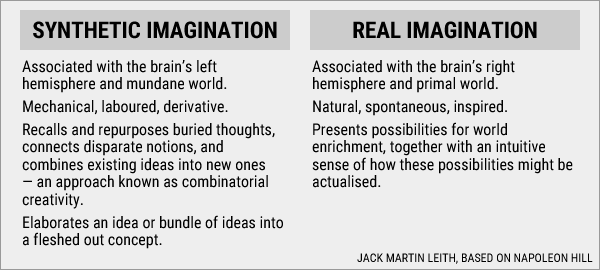In his classic 1937 book Think and Grow Rich (download pdf of entire book), Napoleon Hill contrasts creative imagination with synthetic imagination:
Given that both forms of imagination might be considered creative, creative imagination has been renamed real (in contract to synthetic) imagination.SYNTHETIC IMAGINATION: Through the faculty of synthetic imagination, one may arrange old concepts, ideas, or plans into new combinations1. This faculty creates nothing. It merely works with the material of experience, education, and observation with which it is fed. It is the faculty used most by the inventor, with the exception of he who draws upon the creative imagination, when he cannot solve his problem through synthetic imagination.
CREATIVE IMAGINATION: Through the faculty of creative imagination, the finite mind of man has direct communication with Infinite Intelligence2. It is the faculty through which ‘hunches’ and ‘inspirations’ are received. It is by this faculty that all basic, or new ideas are handed over to man.
1. Today, this is known as combinatorial creativity.
2. Infinite Intelligence is also known as spirit, source, intent and the Tao, and by various other names. But the name is irrelevant: “The Tao that can be told is not the eternal Tao” – Tao Te Ching.
The image below shows the relationship between the two forms of imagination and the brain’s hemispheres. I have not mentioned Infinite Intelligence, a concept (it can only ever be a concept) some readers may find hard to swallow.

Continue reading
External websites
The Epistemic Value of Imagination, by Eshaan Agrawal, on The Classic Journal website
Imagination and Creativity in Organizations (pdf; 22 pages), by Neil A. Thompson, VU University Amsterdam, Netherlands
Imagination — Stanford Encyclopedia of Philosophy
This website
A collection of quotes from people who have experienced real imagination in the course of their work
Should idea conception be left to specialists?
Search the site
Not case sensitive. Do not to hit return.